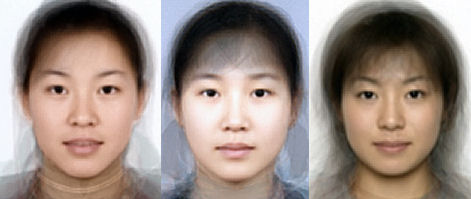
From the paper:
Human Biology Volume 80, Number 3
Comparison of Korean and Japanese Head and Face Anthropometric Characteristics
Hyun-Ja Lee, Se-Jin Park
Abstract
The primary purpose of this research is to collate, compare, and discuss the presently available data for head and face dimensions among Korean and Japanese ethnic groups. Classification of Korean male and female head and face types is simpler than classification of Japanese subjects. Male groups have more statistically significant morphological differences than females, and Japanese subjects display larger values for head and face measurement categories than Korean subjects. Japanese item values for head and face dimensions show distinct differences between male and female subjects compared to Korean subjects. Japanese male subjects have distinct differences from Korean male subjects and relatively lower values for head and face dimensions as age increases compared to Korean male subjects. Generally, female subjects have no regular tendency according to age compared to male subjects.
Link
We are able to show that average Korean head and face shapes differ significantly from Japanese head and face shapes. Koreans have higher BMI than Japanese, and Korean males and females have the same BMI, but the BMI has higher coefficients for males than for females in Japanese.
...
Japanese have a longer head and a larger head length. Nose breadth and mouth breadth of Japanese are larger than those for Koreans, and Japanese have a wider distance between the pupils of the eyes.
...Only ORT, OLT and BMI for Korean male subjects were larger than those for Japanese male subjects; the other Japanese items (weight, TH, RTV, LTV, REV, LEV, SVH, MFH, HL, ORE, OLE, OS, HB, BB, BA, NH, NB, MB, and ID) were higher than those for Koreans. The MB values, in particular, showed the largest difference between Korean and Japanese male subjects.
In the comparison of Korean and Japanese female head and face dimensions, almost all item values show statistically significant differences between the Korean [End Page 325] and Japanese groups, except in the categories of height, HC, ORE, and OLE. HC did not show statistically significant differences between the two female subject groups. Weight, BMI, OS, ORT, OLT, BB, HC, SA, and BIGB for Korean females were larger than those values for Japanese females.
Human Biology Volume 80, Number 3
Comparison of Korean and Japanese Head and Face Anthropometric Characteristics
Hyun-Ja Lee, Se-Jin Park
Abstract
The primary purpose of this research is to collate, compare, and discuss the presently available data for head and face dimensions among Korean and Japanese ethnic groups. Classification of Korean male and female head and face types is simpler than classification of Japanese subjects. Male groups have more statistically significant morphological differences than females, and Japanese subjects display larger values for head and face measurement categories than Korean subjects. Japanese item values for head and face dimensions show distinct differences between male and female subjects compared to Korean subjects. Japanese male subjects have distinct differences from Korean male subjects and relatively lower values for head and face dimensions as age increases compared to Korean male subjects. Generally, female subjects have no regular tendency according to age compared to male subjects.
Link

1 comment:
Post a Comment